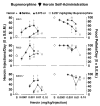EVALUATION OF DRUG ABUSE TREATMENT MEDICATIONS: CONCORDANCE BETWEEN CLINICAL AND PRECLINICAL STUDIES
- PMID: 16906230
- PMCID: PMC1538975
EVALUATION OF DRUG ABUSE TREATMENT MEDICATIONS: CONCORDANCE BETWEEN CLINICAL AND PRECLINICAL STUDIES
Figures













Similar articles
-
Preclinical evaluation of pharmacotherapies for treatment of cocaine and opioid abuse using drug self-administration procedures.Neuropsychopharmacology. 1996 Jun;14(6):375-424. doi: 10.1016/0893-133X(95)00274-H. Neuropsychopharmacology. 1996. PMID: 8726752 Review.
-
Use of Preclinical Drug vs. Food Choice Procedures to Evaluate Candidate Medications for Cocaine Addiction.Curr Treat Options Psychiatry. 2015 Jun;2(2):136-150. doi: 10.1007/s40501-015-0042-9. Curr Treat Options Psychiatry. 2015. PMID: 26009706 Free PMC article.
-
Evaluation of the "Pipeline" for Development of Medications for Cocaine Use Disorder: A Review of Translational Preclinical, Human Laboratory, and Clinical Trial Research.Pharmacol Rev. 2016 Jul;68(3):533-62. doi: 10.1124/pr.115.011668. Pharmacol Rev. 2016. PMID: 27255266 Free PMC article. Review.
-
Utility of preclinical drug versus food choice procedures to evaluate candidate medications for methamphetamine use disorder.Ann N Y Acad Sci. 2017 Apr;1394(1):92-105. doi: 10.1111/nyas.13276. Epub 2016 Dec 9. Ann N Y Acad Sci. 2017. PMID: 27936284 Free PMC article. Review.
-
Drug abuse potential evaluation in animals.Br J Addict. 1991 Dec;86(12):1549-58. doi: 10.1111/j.1360-0443.1991.tb01747.x. Br J Addict. 1991. PMID: 1786486 Review.
Cited by
-
Effects of chronic buspirone treatment on cocaine self-administration.Neuropsychopharmacology. 2013 Feb;38(3):455-67. doi: 10.1038/npp.2012.202. Epub 2012 Oct 17. Neuropsychopharmacology. 2013. PMID: 23072835 Free PMC article.
-
Effects of lorcaserin (Belviq®) on nicotine- and food-maintained responding in non-human primates.Drug Alcohol Depend. 2017 Dec 1;181:94-101. doi: 10.1016/j.drugalcdep.2017.09.008. Epub 2017 Oct 10. Drug Alcohol Depend. 2017. PMID: 29040827 Free PMC article.
-
Effects of chronic varenicline treatment on nicotine, cocaine, and concurrent nicotine+cocaine self-administration.Neuropsychopharmacology. 2014 Apr;39(5):1222-31. doi: 10.1038/npp.2013.325. Epub 2013 Nov 22. Neuropsychopharmacology. 2014. PMID: 24304823 Free PMC article.
-
Mechanisms of withdrawal-associated increases in heroin self-administration: pharmacologic modulation of heroin vs food choice in heroin-dependent rhesus monkeys.Neuropsychopharmacology. 2009 Mar;34(4):899-911. doi: 10.1038/npp.2008.127. Epub 2008 Aug 13. Neuropsychopharmacology. 2009. PMID: 18704098 Free PMC article.
-
Effects of chronic buspirone treatment on nicotine and concurrent nicotine+cocaine self-administration.Neuropsychopharmacology. 2013 Jun;38(7):1264-75. doi: 10.1038/npp.2013.25. Epub 2013 Jan 21. Neuropsychopharmacology. 2013. PMID: 23337868 Free PMC article.
References
References for the Preface
-
- Evans SM, Haney M, Fischman MW, Foltin RW. Limited sex differences in response to “binge” smoked cocaine use in humans. Neuropsychopharmacology. 1999;21:445–454. - PubMed
-
- Fischman MW. The behavioral pharmacology of cocaiine in humans. NIDA Res Monogr. 1984;50:72–91. - PubMed
-
- Fischman, M. W. Cocaine and the amphetamines, in Psychopharmacology, The Third Generation of Progress (Meltzer, H. Y.; ed) New York: Raven Press, 1987, pp. 1543–1553.
-
- Fischman MW. Human drug taking under controlled laboratory conditions. NIDA Res Monogr. 1988;84:196–211. - PubMed
-
- Fischman MW, Foltin RW. A laboratory model for evaluating potential treatment medications in humans. NIDA Res Monogr. 1992;119:165–169. - PubMed
References
-
- Banks CD. Overdose of buprenorphine: Case report. NZ Med J. 1979;89:255–256. - PubMed
-
- Brady, J. V., and Griffiths, R. R. Drug-maintained performance procedures and the assessment of drug-abuse liability, in Predictiing Dependence Liability of Stimulant and Depressant Drugs (Thompson, T.; and Unna, K. R.; eds), Baltimore, MD: University Park Press, 1977, pp. 165–184.
-
- Condelli WS, Fairbank JA, Dennis ML, Rachal JV. Cocaine use by clients in methadone programs: Significance, scope, and behavioral interventions. J Subst Abuse Treat. 1991;8:203–212. - PubMed
-
- Cowan, A., and Lewis, J. W. eds Buprenorphine: Combatting Drug Abuse with a Unique Opioid New York: Wiley-Liss, Inc., 1995.
-
- Deneau G, Yanagita T, Seevers MH. Self-administration of psychoactive substances by the monkey. Psychopharmacologia. 1969;16:30–48. - PubMed
Grants and funding
LinkOut - more resources
Full Text Sources
